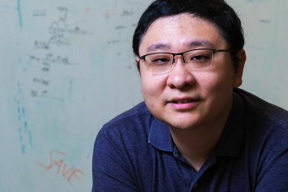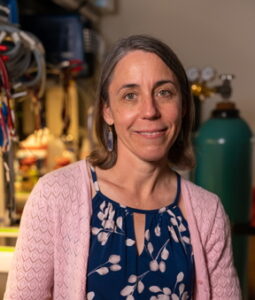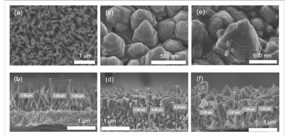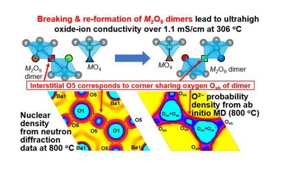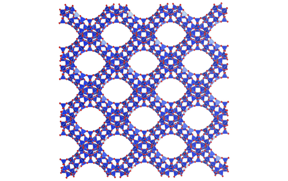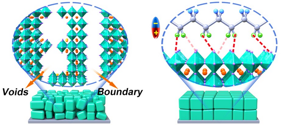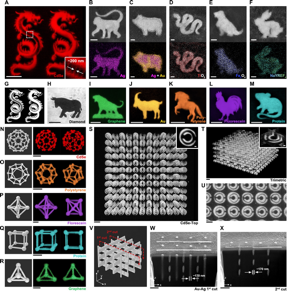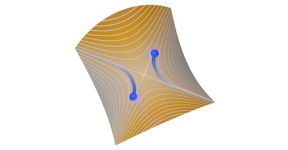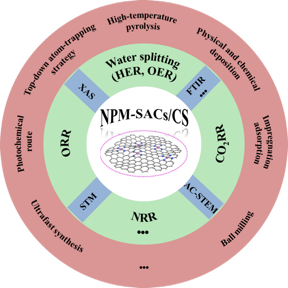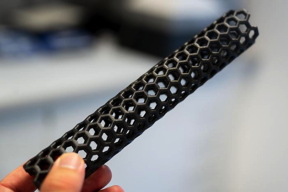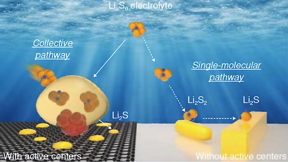Home > Press > Interdisciplinary: Rice team tackles the future of semiconductors Multiferroics could be the key to ultralow-energy computing
| Kaiyuan Yang is an associate professor of electrical and computer engineering at Rice University. CREDIT (Photo by Jeff Fitlow/Rice University) |
Abstract:
An interdisciplinary team of Rice University scientists has won a $1.9 million National Science Foundation grant for research on materials that could serve as the basis for next-generation energy-efficient computing devices.
Interdisciplinary: Rice team tackles the future of semiconductors Multiferroics could be the key to ultralow-energy computing
Houston, TX | Posted on October 6th, 2023The team ⎯ led by Kaiyuan Yang and including co-investigators Ramamoorthy Ramesh, Yimo Han, Douglas Natelson, Shengxi Huang and Lane Martin ⎯ will focus on multiferroics, materials with distinctive electric and magnetic properties that carry “transformative technological potential,” said Ramesh, who is a leading expert in the field. Specifically, the researchers will seek to leverage the spin and charge of electrons in multiferroics in order to process and store information.
The project is supported by the NSF Future of Semiconductors (FuSe) program through a public-private partnership between the NSF and four leading technology corporations. The FuSe initiative aims to “enable rapid progress in new semiconductor technologies and manufacturing as well as workforce development,” according to the agency’s website.
“By 2030, about 25% of global energy demand will come from electronics ⎯ that’s a pretty huge number,” said Ramesh, Rice’s executive vice president for research and professor of materials science and nanoengineering and of physics and astronomy. “With this FuSe grant, our goal is to lower energy consumption for computing. We put together a perfect team to help push the limits of the science and take significant strides toward actually making these low-energy computing devices a reality.”
Rice’s project, titled “Ultra-Low-Energy Logic-in-Memory Computing using Multiferroic Spintronics,” is one of 24 research and education projects funded under the $45.6 million initiative, which includes funding from the 2022 CHIPS and Science Act ⎯ keystone bipartisan legislation that aims to secure a leading role for the U.S. in numerous technological fields including nanotechnology, quantum computing, artificial intelligence and clean energy.
“Existing computing devices are based on silicon and complementary metal-oxide-semiconductor (CMOS) chips,” Yang said. “This technology has major limitations that lead to high energy consumption and limited throughput for large-scale artificial intelligence (AI) computing and massive data mining applications. One of these limitations is that all CMOS-based semiconductor devices generate a certain amount of thermal noise (random heat).”
Lowering operating voltage is the prerequisite to improving these devices’ energy consumption, but the technology is facing an impasse.
“You cannot lower your operating voltage below a certain value, or your signal will get drowned out in that thermal noise,” said Yang, an associate professor of electrical and computer engineering.
Another major limitation in current mainstream processors is that computing and memory tasks are performed separately, leading to major inefficiencies.
“Most of the time, you’re just moving information back and forth between where memory is stored and where logic operations take place,” Ramesh said. “Up to 70% of the energy consumed is squandered in this transfer. Imagine needing to move funds between bank accounts in New York and, say, Zurich every few hours ⎯ you’d lose so much in commissions you could go broke.”
The hope is that multiferroics-based devices would not only improve computing energy efficiency by as much as three orders of magnitude, but that it would also enable a seamless integration of memory and logic functions.
“A single device could simultaneously be both a memory cell and a computing gate,” said Yang, whose expertise is rooted in circuit design and processing architectures. “I will help lead the knowledge derived from fundamental research on multiferroics toward an actual computing application.”
In order for that to happen, the team will work on gaining an in-depth understanding of multiferroics.
Huang, an associate professor of electrical and computer engineering, plans to use high-throughput, noninvasive methods to characterize the materials, their interfaces and the devices made from them.
“I will work closely with the PIs on material synthesis, atomic characterization and device fabrication to achieve the goal of multiferroic spintronic devices and systems,” said Huang, who hopes such materials and devices will play a part in overcoming energy bottlenecks in current mainstream technologies.
Han, an assistant professor of materials science and nanoengineering, will perform advanced, atomic-level imaging to help improve and debug the material.
“Low-power computing is a very important direction for the semiconductor industry to pursue, and we’re developing the materials that will enable it to do so,” said Han, who emphasized the timeliness and urgency of the research by noting that the energy needed to train an AI-powered language model like ChatGPT could power the city of Houston for a whole year.
Natelson, whose research group will help with the device fabrication and electrical measurements of the multiferroics’ critical properties, said the “top notch combination of people and expertise” will hopefully find creative ways to “combine logic and memory in individual devices that operate at much lower voltages than present technologies.”
“It’s great that the Rice team has been selected to be part of this important program,” said Natelson, a professor of physics and astronomy. “This is an opportunity to have a major impact on this urgent technical need while doing some excellent basic research.”
Team members span a broad range of expertise from fundamental materials research to device physics to circuit design and architectures, showcasing a core Rice strength of working across disciplinary boundaries and fueling innovation through collaboration.
“Real problems are at the boundaries between research fields,” said Martin, who leads the Rice Advanced Materials Institute (RAMI) ⎯ one of a constellation of recent university initiatives intended to foster research collaboration and accelerate innovation. “No single person could take on what is truly an existential challenge for the computing field, so we’ve put together a great combination of people across different programs and departments.”
The institute led by Martin will be housed in the Ralph S. O’Connor Building for Engineering and Science, a landmark new research facility the university hopes will attract and retain talented faculty and graduate students with its customizable, cutting-edge labs and amenities.
“In a sense, RAMI is the embodiment of the collaborative, interdisciplinary spirit that brought this team together,” said Martin, Rice’s Welch Professor of Materials Science and Nanoengineering and a professor of physics and astronomy. “The institute seeks to amplify the impact generated by research collaborations such as this one in order to address some of these generational challenges like the limitations of current computing technologies.”
####
About Rice University
Located on a 300-acre forested campus in Houston, Rice University is consistently ranked among the nation’s top 20 universities by U.S. News & World Report. Rice has highly respected schools of Architecture, Business, Continuing Studies, Engineering, Humanities, Music, Natural Sciences and Social Sciences and is home to the Baker Institute for Public Policy. With 4,552 undergraduates and 3,998 graduate students, Rice’s undergraduate student-to-faculty ratio is just under 6-to-1. Its residential college system builds close-knit communities and lifelong friendships, just one reason why Rice is ranked No. 1 for lots of race/class interaction and No. 4 for quality of life by the Princeton Review. Rice is also rated as a best value among private universities by Kiplinger’s Personal Finance.
For more information, please click here
Contacts:
Silvia Cernea Clark
Rice University
Office: 7133486728
Copyright © Rice University
If you have a comment, please Contact us.Issuers of news releases, not 7th Wave, Inc. or Nanotechnology Now, are solely responsible for the accuracy of the content.
| Related News Press |
News and information
![]() Observation of left and right at nanoscale with optical force October 6th, 2023
Observation of left and right at nanoscale with optical force October 6th, 2023
![]() The efficient perovskite cells with a structured anti-reflective layer – another step towards commercialization on a wider scale October 6th, 2023
The efficient perovskite cells with a structured anti-reflective layer – another step towards commercialization on a wider scale October 6th, 2023
![]() Super-efficient laser light-induced detection of cancer cell-derived nanoparticles: Skipping ultracentrifugation, detection time reduced from hours to minutes! October 6th, 2023
Super-efficient laser light-induced detection of cancer cell-derived nanoparticles: Skipping ultracentrifugation, detection time reduced from hours to minutes! October 6th, 2023
![]() Successful morphing of inorganic perovskites without damaging their functional properties October 6th, 2023
Successful morphing of inorganic perovskites without damaging their functional properties October 6th, 2023
Possible Futures
![]() Discovery made by University of Warsaw scientists may enable network interface for quantum computers October 6th, 2023
Discovery made by University of Warsaw scientists may enable network interface for quantum computers October 6th, 2023
![]() The medicine of the future could be artificial life forms October 6th, 2023
The medicine of the future could be artificial life forms October 6th, 2023
![]() Successful morphing of inorganic perovskites without damaging their functional properties October 6th, 2023
Successful morphing of inorganic perovskites without damaging their functional properties October 6th, 2023
Chip Technology
![]() A new qubit platform is created atom by atom October 6th, 2023
A new qubit platform is created atom by atom October 6th, 2023
![]() Twisted science: NIST researchers find a new quantum ruler to explore exotic matter October 6th, 2023
Twisted science: NIST researchers find a new quantum ruler to explore exotic matter October 6th, 2023
![]() Successful morphing of inorganic perovskites without damaging their functional properties October 6th, 2023
Successful morphing of inorganic perovskites without damaging their functional properties October 6th, 2023
Memory Technology
![]() Researchers discover materials exhibiting huge magnetoresistance June 9th, 2023
Researchers discover materials exhibiting huge magnetoresistance June 9th, 2023
Nanoelectronics
![]() Key element for a scalable quantum computer: Physicists from Forschungszentrum Jülich and RWTH Aachen University demonstrate electron transport on a quantum chip September 23rd, 2022
Key element for a scalable quantum computer: Physicists from Forschungszentrum Jülich and RWTH Aachen University demonstrate electron transport on a quantum chip September 23rd, 2022
![]() Reduced power consumption in semiconductor devices September 23rd, 2022
Reduced power consumption in semiconductor devices September 23rd, 2022
![]() Atomic level deposition to extend Moore’s law and beyond July 15th, 2022
Atomic level deposition to extend Moore’s law and beyond July 15th, 2022
![]() Controlled synthesis of crystal flakes paves path for advanced future electronics June 17th, 2022
Controlled synthesis of crystal flakes paves path for advanced future electronics June 17th, 2022
Discoveries
![]() Super-efficient laser light-induced detection of cancer cell-derived nanoparticles: Skipping ultracentrifugation, detection time reduced from hours to minutes! October 6th, 2023
Super-efficient laser light-induced detection of cancer cell-derived nanoparticles: Skipping ultracentrifugation, detection time reduced from hours to minutes! October 6th, 2023
![]() A new qubit platform is created atom by atom October 6th, 2023
A new qubit platform is created atom by atom October 6th, 2023
![]() Twisted science: NIST researchers find a new quantum ruler to explore exotic matter October 6th, 2023
Twisted science: NIST researchers find a new quantum ruler to explore exotic matter October 6th, 2023
![]() Discovery made by University of Warsaw scientists may enable network interface for quantum computers October 6th, 2023
Discovery made by University of Warsaw scientists may enable network interface for quantum computers October 6th, 2023
Announcements
![]() Observation of left and right at nanoscale with optical force October 6th, 2023
Observation of left and right at nanoscale with optical force October 6th, 2023
![]() The efficient perovskite cells with a structured anti-reflective layer – another step towards commercialization on a wider scale October 6th, 2023
The efficient perovskite cells with a structured anti-reflective layer – another step towards commercialization on a wider scale October 6th, 2023
![]() Super-efficient laser light-induced detection of cancer cell-derived nanoparticles: Skipping ultracentrifugation, detection time reduced from hours to minutes! October 6th, 2023
Super-efficient laser light-induced detection of cancer cell-derived nanoparticles: Skipping ultracentrifugation, detection time reduced from hours to minutes! October 6th, 2023
![]() A new qubit platform is created atom by atom October 6th, 2023
A new qubit platform is created atom by atom October 6th, 2023
- SEO Powered Content & PR Distribution. Get Amplified Today.
- PlatoData.Network Vertical Generative Ai. Empower Yourself. Access Here.
- PlatoAiStream. Web3 Intelligence. Knowledge Amplified. Access Here.
- PlatoESG. Carbon, CleanTech, Energy, Environment, Solar, Waste Management. Access Here.
- PlatoHealth. Biotech and Clinical Trials Intelligence. Access Here.
- Source: http://www.nanotech-now.com/news.cgi?story_id=57396
- :has
- :is
- :not
- :where
- 1
- 10
- 12th
- 17th
- 20
- 2022
- 2030
- 24
- 26
- 3rd
- 6th
- 7th
- 9
- 9th
- a
- About
- accelerate
- According
- Accounts
- accuracy
- Achieve
- across
- Act
- actual
- actually
- address
- advanced
- Advanced materials
- adverse
- AI
- AI-powered
- aims
- All
- also
- amenities
- among
- amount
- amplify
- an
- and
- Another
- Application
- applications
- approach
- architecture
- ARE
- artificial
- artificial intelligence
- Artificial intelligence (AI)
- AS
- Assistant
- Associate
- astronomy
- At
- atom
- attract
- AUGUST
- back
- baker
- Bank
- bank accounts
- based
- basic
- basis
- BE
- been
- below
- BEST
- between
- bipartisan
- both
- bottlenecks
- boundaries
- broad
- Broke
- brought
- Building
- builds
- business
- but
- by
- Campus
- CAN
- Cancer
- cannot
- carbon
- carry
- cell
- Cells
- Center
- certain
- CGI
- challenge
- challenges
- characterize
- charge
- ChatGPT
- Chips
- City
- clean energy
- click
- closely
- collaboration
- collaborations
- collaborative
- College
- COM
- combination
- come
- comment
- commercialization
- commissions
- Communities
- Complement
- complementary
- computer
- Computer Engineering
- computing
- consistently
- consumed
- consumption
- content
- continuing
- Conversion
- Core
- Corporations
- could
- created
- Creative
- credit
- critical
- Crystal
- Current
- customizable
- cutting-edge
- damaging
- data
- data mining
- Demand
- demonstrate
- departments
- Derived
- Design
- Detection
- develop
- developing
- Development
- device
- Devices
- different
- direction
- disciplinary
- discover
- distinctive
- do
- doing
- douglas
- drowned
- dynamics
- Education
- effects
- efficiency
- efficient
- Electric
- Electronic
- Electronics
- electrons
- element
- embodiment
- emphasized
- enable
- end
- energy
- Energy Consumption
- energy efficiency
- Engineering
- Ether (ETH)
- Every
- excellent
- executive
- Exhibiting
- existential
- Exotic
- expert
- expertise
- explore
- extend
- fabricating
- Facility
- facing
- few
- fewer
- field
- Fields
- films
- finance
- Find
- flexible
- Focus
- For
- forth
- Foster
- Foundation
- four
- from
- functional
- functions
- fundamental
- funded
- funding
- funds
- future
- gaining
- generate
- generated
- generational
- get
- gif
- Global
- Go
- goal
- graduate
- grant
- great
- Group
- happen
- Have
- help
- High
- highly
- Home
- hope
- Hopefully
- hopes
- HOURS
- houston
- http
- HTTPS
- huang
- huge
- identify
- if
- imagine
- Imaging
- Impact
- important
- improve
- improving
- in
- in-depth
- Inc.
- includes
- Including
- individual
- industry
- inefficiencies
- inexpensive
- information
- Initiative
- initiatives
- Innovation
- innovative
- insights
- Institute
- integration
- Intelligence
- intended
- interaction
- Interface
- interfaces
- IT
- ITS
- jpg
- July
- june
- just
- just one
- Key
- knowledge
- Labs
- landmark
- Lane
- language
- large-scale
- laser
- Law
- layer
- lead
- leading
- Leads
- Led
- left
- Legislation
- Level
- Leverage
- Life
- like
- limitation
- limitations
- Limited
- limits
- links
- logic
- lose
- lots
- lower
- made
- Mainstream
- major
- make
- Making
- manufacturing
- March
- Martin
- massive
- material
- materials
- May..
- measurements
- measuring
- medicine
- Members
- Memory
- method
- methods
- million
- Mining
- model
- more
- move
- moving
- much
- Music
- nanotechnology
- National
- National Science
- Nations
- Natural
- Need
- needed
- needing
- net
- network
- New
- New York
- news
- next-generation
- nist
- no
- Noise
- noting
- now
- NSF
- number
- numerous
- october
- of
- on
- ONE
- only
- operate
- operating
- Operations
- Opportunity
- or
- order
- orders
- our
- out
- overcoming
- part
- Partnership
- path
- People
- perfect
- perform
- performed
- person
- personal
- Personal Finance
- photo
- PHP
- Physics
- Place
- plans
- plastic
- platform
- plato
- Plato Data Intelligence
- PlatoData
- Play
- please
- policy
- Post
- posted
- potential
- power
- present
- president
- press
- Press Release
- pretty
- princeton
- private
- problems
- process
- processing
- processors
- produces
- Professor
- Program
- Programs
- Progress
- project
- projects
- promising
- properties
- propose
- proposed
- public
- pursue
- Push
- put
- quality
- Quantum
- Quantum Computer
- quantum computing
- Qubit
- RAMI
- random
- range
- ranked
- rapid
- rated
- ratio
- reactions
- Reality
- reason
- recent
- reduce
- Reduced
- release
- Releases
- report
- research
- research collaboration
- research group
- researcher
- researchers
- residential
- respected
- responsible
- retain
- return
- review
- Rice
- right
- Role
- rooted
- s
- safer
- Said
- Save
- say
- scalable
- Schools
- Science
- SCIENCES
- scientists
- seamless
- Search
- secure
- Seek
- Seeks
- selected
- semiconductor
- Semiconductors
- sense
- sensors
- September
- serve
- Share
- showcasing
- Shows
- side
- Signal
- significant
- Silicon
- Simple
- simultaneously
- single
- So
- Social
- solely
- some
- span
- specifically
- Spin
- spirit
- start
- Step
- storage
- store
- stored
- Strategy
- strength
- strides
- structured
- Students
- studies
- Study
- submit
- such
- suitable
- Supported
- system
- Systems
- Tackles
- Take
- talented
- tasks
- team
- Technical
- technological
- Technologies
- Technology
- than
- that
- The
- The Future
- their
- Them
- thermal
- These
- this
- three
- Through
- throughput
- time
- titled
- to
- together
- tool
- top
- toward
- towards
- Train
- transfer
- transport
- Trevor
- truly
- TX
- u.s.
- under
- understanding
- Universities
- university
- unwanted
- urgency
- urgent
- us
- use
- uses
- using
- value
- very
- vice
- Vice President
- Voltage
- Warsaw
- Wave
- ways
- we
- Website
- WELL
- What
- What is
- which
- while
- WHO
- whole
- whose
- why
- wider
- will
- with
- without
- Won
- Work
- Workforce
- Workforce Development
- working
- world
- would
- Yahoo
- year
- york
- you
- Your
- zephyrnet
- Zurich

